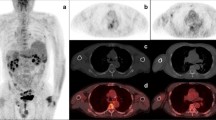Abstract
Technetium-99m 2-methoxyisobutylisonitrile (99mTc-MIBI or setamibi) has recently been proposed for use in the evaluation of multiple myeloma (MM). The aims of this study were to investigate its potential predictive value in patients with MM and its possible role in the follow-up. Thirty patients with MM who had undergone two 99mTc-MIBI scintigraphic studies at least 2 months apart constituted the study group; 22 of them received chemotherapy in the interval between the two scans. The scans were classified as showing pattern N when only physiological uptake was present, pattern D when diffuse bone marrow uptake was observed, pattern F when areas of focal uptake of the tracer were evident, and pattern F+D when both D and F patterns were observed. Comparative 99mTc-MIBI scintigraphy was considered indicative of disease progression when there was a worsening of the pattern (i.e. from N to D, or from N or D to F or to F+D) or an increase in the pattern D semiquantitative score. It was considered indicative of disease improvement when the opposite trend was observed; otherwise, it was considered to document a stable condition. A significant association was observed between the baseline scintigraphic pattern and clinical status at follow-up in the group of patients evaluated after chemotherapy (χ2=16.7, P<0.05). A negative baseline 99mTc-MIBI scintigram showed a high predictive accuracy (100%) for remission, while the presence of pattern F or F+D was often associated with a less favourable outcome. A multivariate analysis showed that 99mTc-MIBI uptake pattern has an added value in relation to known prognostic variables such as C-reactive protein. 99mTc-MIBI scintigraphy patterns at follow-up were significantly associated with the clinical status evaluated after chemotherapy (χ2=32.6, P<0.0001). Considering pattern N as indicating remission, pattern D stable condition, and pattern F or F+D progressive disease, a high concordance between scintigraphic findings and clinical status was found in the 22 patients undergoing chemotherapy (91%). Variation in 99mTc-MIBI findings comparing baseline and follow-up evaluations was significantly associated with clinical status both in patients undergoing chemotherapy (χ2=26.5, P<0.0005) and in those not undergoing chemotherapy (χ2=8.0, P<0.005). In conclusion, the results of this study suggest a prognostic value of 99mTc-MIBI scintigraphy in patients with MM and a potential role during the follow-up.
Similar content being viewed by others
Author information
Authors and Affiliations
Additional information
Received 17 June and in revised form 26 October 2000
Electronic Publication
Rights and permissions
About this article
Cite this article
Pace, L., Catalano, L., Del Vecchio, S. et al. Predictive value of technetium-99m sestamibi in patients with multiple myeloma and potential role in the follow-up. Eur J Nucl Med 28, 304–312 (2001). https://doi.org/10.1007/s002590000440
Published:
Issue Date:
DOI: https://doi.org/10.1007/s002590000440




